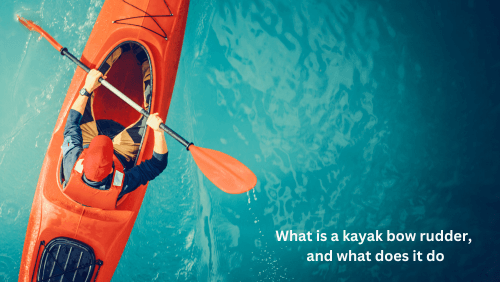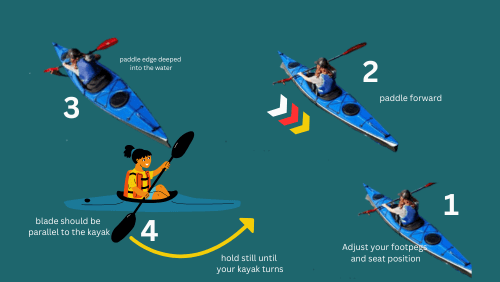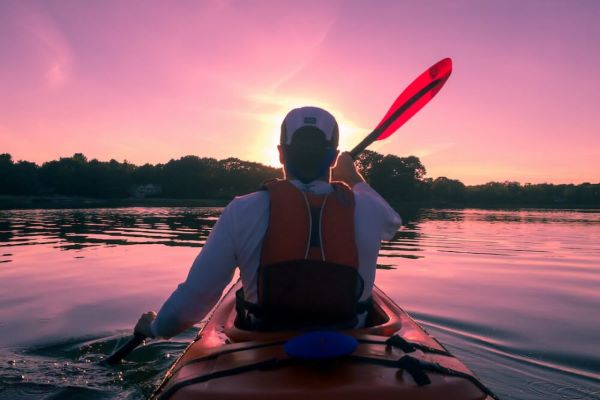Ok, so you’ve decided to add a kayak bow rudder to your quiver of kayaking skills. Good for you! The bow rudder is an essential stroke for anyone who wants to be a well-rounded kayaker.
It can help you make smooth turns, even in fast-flowing water, and it’s the perfect way to show those pesky up-streamers that you’re not afraid of a little challenge.
In this post, you’ll learn tips on how to use the kayak bow rudder like a pro. So read on, and get ready to take your kayaking skills to the next level!
1. What is a kayak bow rudder, and what does it do

The kayak bow rudder is a move that allows you to quickly and easily turn your kayak in any direction when your kayak is in motion. It can be used for turning in place, or for making quick escapes or changes in direction.
The bow rudder is a great move to know for any kayaker, regardless of experience level. However, it is mostly used by whitewater kayakers.
2. How to use the kayak bow rudder for the first time: a step-by-step guide.

Your bow rudder draw is executed when your kayak is already in motion
First things first: you’ll need to know how to properly set up your kayak for using the bow rudder. Here are the steps:
- Adjust your footpegs and seat position so that you’re in a comfortable and stable position.
- Make sure you are in the correct paddling position.
- Then, perform a forward sweep stroke in the opposite direction you desire to turn.
- This should set your kayak for using the bow rudder stroke.
Once you are set up for the draw stroke, you can then execute the bow rudder stroke by following these steps;
- Make sure that your paddle is in the correct position – your blade should be on the side of the kayak you want to turn.
- The blade should be parallel to the kayak when immersed in water.
- Then slightly turn your leading edge away from your kayak to steer your kayak in that direction.
- Performing the bow draw rudder can slow down your speed.
Note that if your kayak refuses to turn with this stroke, you can easily transition to the bow/draw rudder.
Here is how to transition to a bow/draw rudder from a bow rudder;
- After going through steps 1 to 4 above and your kayak refuses to turn,
- While your paddle blade is still immersed in water in the bow rudder position, move it slightly so the position of your blade in the water is almost even with your shin.
Now that your kayak is set up correctly, it’s time to learn how to master the kayak bow rudder.
3. Tips for mastering the kayak bow rudder

Mastering the kayak bow rudder can take some practice, but with a little patience and perseverance, you’ll be able to use it like a pro!
Here are a few tips to help you get started:
1. Start by practicing in calm water, and then gradually work your way up to more challenging environments.
2. Remember to always stay safe while kayaking, and never attempt anything that’s beyond your skill level.
3. Use the bow rudder in combination with other kayaking techniques, such as the sweep stroke and the bow/draw rudder.
4. The key to mastering the bow rudder is practice – so be sure to practice often in a variety of conditions!
4. The benefits of using a kayak bow rudder

So what are some of the benefits of using a kayak bow rudder? Here are just a few:
1. Quick and easy turns – The bow rudder allows you to make quick and easy turns without having to reposition yourself or your kayak. This can come in handy if you need to make a quick escape or change directions in a hurry.
2. Increased control – The bow rudder gives you greater control over your kayak, allowing you to navigate through tight spaces and avoid obstacles with ease.
3. Enhanced stability – The bow rudder helps to improve your kayak’s stability, making it less likely to capsize in challenging conditions.
4. Braking system – the bow rudder can help slow your kayak’s speed, which can be useful if you are fast approaching an obstacle that you need to avoid.
5. Added versatility – The bow rudder adds an extra level of versatility to your paddling arsenal, giving you more options for navigating through waterways.
Conclusion
Overall, the kayak bow rudder is a great move to know for any kayaker looking to improve their paddling skills. Whether you’re navigating through tight spaces or trying to escape from danger, this technique can help you turn quickly and easily while maximizing your control and stability. So if you’re serious about your kayaking, be sure to add the bow rudder to your repertoire!
FAQs about kayak bow rudders
1. How do I know when to use the bow rudder?
The bow rudder should be used whenever you need to make a quick turn or change directions in a hurry. It can also be helpful for navigating through tight spaces and avoiding obstacles.
2. How do I set up my kayak for using the bow rudder?
To set up your kayak for using the bow rudder, you first need to adjust your foot pegs and seat position so that you’re in a comfortable and stable position. Next, make sure you are in the correct paddling position. Then, perform a forward sweep stroke in the opposite direction you desire to turn. This should set your kayak for using the bow rudder stroke.
3. How do I execute the bow rudder stroke?
To execute the bow rudder stroke, make sure that your paddle is in the correct position – your blade should be on the side of the kayak you want to turn. The blade should be initially parallel to the kayak when immersed in water. Then, slightly turn your leading edge away from your kayak to steer your kayak in that direction.
4. What are some of the benefits of using a kayak bow rudder?
The benefits of using a kayak bow rudder include quick and easy turns, increased control, enhanced stability, braking system, and added versatility.
Leave a comment below if you have any other questions about kayak bow rudders! We hope this article and FAQs have been helpful in answering some of your questions. Happy paddling!

I have canoeing and kayaking for a long time. My kayaking has been done primarily in lakes for fishing. Although I think I can handle a kayak pretty well, I did not know the names of the various strokes I have been shown by more experienced people. You explanation of the bow rudder stroke is clear and easy to follow. My work took me to several Inuit communities on the southern part of Hudson’s Bay. I was invited by an Inuit friend to go Narwhale hunting. He showed me a two person kayak and I decided to watch the hunt from the beach. I enjoy kayaking more than canoeing because the kayak is easier to move onland and much more manuverable in the water. I will work on the bow rudder as you explained it.
Jim
Hi Jim,
Thank you for your feedback! It’s great to hear that you found the explanation of the bow rudder stroke clear and helpful. It sounds like you have some fascinating experiences with both kayaking and canoeing. Your time in the Inuit communities must have been incredible, and it’s interesting to hear about your preference for kayaking due to its maneuverability.
I’m glad you’re looking forward to working on the bow rudder technique. If you have any more questions or need further clarification as you practice, feel free to reach out, and best of luck with your kayaking adventures. Happy paddling!
This is a master move! I didn’t know that this technique had a name! I remember doing kayak when I went in holidays with many children of my age. We did kayak once, and I think I did this technique without knowing it! I just happened to intuitively find out how to move faster with my mates. Anyway, you masterfully describe this technique very well. Hope to read more from you in the future.
Thank you for the great feedback! It’s fantastic to hear that you discovered this technique intuitively during your kayaking adventures. Sometimes, the best skills come from natural experimentation and exploration.
I’m glad the article helped put a name to the technique and provided clarity on how it works. I’m looking forward to sharing more insights and tips in the future. If you have any more questions or topics you’re curious about, feel free to let me know! Happy Paddling!
Hi Martins,
Great article! I found the step-by-step guide on using the kayak bow rudder very helpful, especially the emphasis on practicing in different conditions.
One aspect I’m curious about is how the kayak bow rudder affects speed. Does using the bow rudder significantly slow down the kayak, and are there ways to minimize any speed reduction while still maintaining control?
Additionally, any insights on how this technique compares to other steering methods in terms of efficiency would be appreciated.
Thanks for sharing such detailed tips!
Hi there,
Thanks for the kind words! I’m glad you found the guide on the kayak bow rudder helpful.
Regarding your question about speed, using the bow rudder can have a slight impact on speed, as it introduces additional drag. However, the reduction in speed is generally minimal compared to the benefits of improved control and maneuverability. To minimize speed reduction, focus on making smooth, precise adjustments with the rudder and avoid excessive or abrupt movements.
When comparing the bow rudder to other steering methods, such as the stern rudder or edging techniques, the bow rudder tends to offer better control in tight turns and when navigating complex water conditions. It can be more efficient in situations where precise maneuvering is crucial, though it might not always be the fastest method for maintaining straight-line speed.
I hope this helps! If you have more questions or need further clarification, feel free to ask. Happy Paddling!
Hi there
The article on Kayaking Info about mastering the kayak bow rudder is a fantastic resource for kayakers looking to refine their technique. It offers clear, step-by-step instructions and valuable tips that can help both beginners and experienced paddlers improve their control and maneuverability on the water. The emphasis on practice and safety is particularly commendable.
Have you had the chance to try out any of these techniques on your kayaking adventures?
Thank you for your positive feedback! I’m glad you found the article useful and appreciate the emphasis on practice and safety. Yes, I have had the opportunity to try out these techniques during my kayaking adventures. They’ve definitely enhanced my control and maneuverability on the water. It’s always rewarding to see how refining these skills can make a difference in both calm and challenging conditions. If you have any personal experiences with the bow rudder or other techniques, I’d love to hear about them! Happy Paddling!
These instructions are the best I’ve ever read for this stroke, and several teachers have tried to get them across to me. You are very experienced. But I am scared of capsizing because I have asthma, and so I dread being underwater and not being able to breathe! Even though I always wear a life jacket, I’m still scared. Any tips?
I think your bow rudder post would be even better with some diagrams, which I’m sure you could get AI to create if you can’t create them yourself or provide photos.
May I ask where you kayak? I live in Japan so things are a little different here.
Thank you for your kind words about the instructions! I’m glad they’ve been helpful. I understand your concern about capsizing, especially with asthma. Here are a few tips to help you feel more secure:
Practice in Calm Conditions: Start in calm, shallow waters where you can practice getting back into your kayak if needed.
Breathing Techniques: Work on controlled breathing exercises to manage anxiety and improve your comfort with the possibility of being underwater.
Emergency Skills: Make sure you’re familiar with self-rescue techniques and practice them regularly. Consider taking a course on water safety if you haven’t already.
Communication: Let your kayaking companions know about your concerns so they can assist you in case of an emergency.
As for diagrams for the bow rudder post, that’s a great idea! i have added some visuals to enhance the guide.
I kayak in various locations, depending on the conditions and season. It’s fascinating to hear you’re kayaking in Japan—what unique experiences have you had there? Happy Paddling!